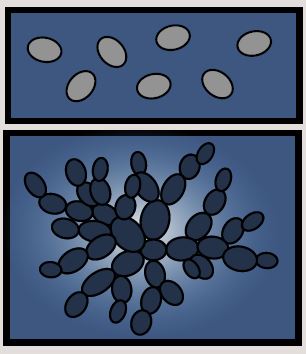The craft beer movement gave rise to an immense diversity of brews. From porters and pale ales to dubels and dunkels, there is a seemingly infinite supply of tasty adult beverages to enjoy. Even within the ales, beer drinkers can choose among ambers, blondes, browns, coffees, and creams. Each of these brews is defined by a unique combination of hops and malt, coupled with fine-tuned boiling, fermenting, and filtering. But one essential ingredient—brewer’s yeast—underlies the vast majority of beers on tap today.

Brewers, cicerones, and everyday beer drinkers all love brewer’s yeast. Scientists love this special yeast too, not only for its fundamental role in brewing, but also because it’s a perfect organism to use in experiments. It’s small, easy to grow in the lab, reproduces quickly, and has its genome sequenced, which makes brewer’s yeast a model system for research. Scientists also use brewer’s yeast to explore questions about biodiversity and to watch evolution happen in real time.
In experimental evolution studies, scientists observe how organisms grow, change, go extinct, or give rise to new forms of life. To do this, researchers grow a population of organisms, like brewer’s yeast, in a particular environment. The next day, a subset of this population is transferred to a new environment. This process is repeated every day for weeks, months, or decades. Over time, the yeast populations evolve, changing in appearance, function, and genetic composition. By comparing the first and final populations, scientists learn about how evolution operates and what factors drive the diversity of life.
In a paper recently published in The American Naturalist, Maria Rebolleda-Gomez and Michael Travisano used experimental evolution in brewer’s yeast to explore how multicellular life arose and what challenges might stand in the way. Multicellularity evolved at least 25 times throughout history and is thought to be beneficial for a variety of reasons including division of labor among cells and reduced predation. Although it may seem like these benefits far outweigh the costs, this study revealed this isn’t always the case.
Brewer’s yeast is an ideal system for studying the evolution of multicellularity because it exists in unicellular and multicellular forms. Snowflake yeast, the multicellular form, consists of cells that stick together in a pattern that resembles a snowflake. In their study, Rebolleda-Gomez and Travisano asked whether the larger size of snowflake yeast limits their ability to acquire resources and disperse, two ecological costs that may impact the evolution of multicellularity.

To test these ideas, the researchers set up an experimental evolution study where they started populations with only snowflake yeasts. After four days, nearly all the snowflake yeasts evolved into single-celled forms. Once they underwent these evolutionary reversals to unicellularity, they never transitioned back into snowflakes. “These results were very surprising,” says Rebolleda-Gomez, evolutionary biologist at the University of Pittsburgh and lead author of the study. “It makes sense once you figure out what’s going on, but it wasn’t obvious when we started.”

To determine why being multicellular was disadvantageous in yeast, the researchers created a model to simulate how size and dispersal affect the cost of being a snowflake. They discovered that larger snowflakes experienced greater competition for local resources because individual cells that comprise a snowflake compete against one another for food. Larger snowflakes also moved slowly, limiting their ability to disperse to new environments with more resources. Smaller single-celled yeasts didn’t face these challenges. Within 24 hours, they dominated the simulated environment despite starting as only half of the population. These results were consistent with the experimental evolution study. Because smaller yeasts were better at dispersing to new environments and acquiring resources, over time all the large snowflakes evolved into more successful single-celled forms.
By showing how ecology impacts the evolution of snowflake yeast, this study flips the narrative on how multicellularity evolved and when it’s beneficial. “The takeaway for me is that ecology really matters when thinking about these major transitions in evolution,” says William Ratcliff, an evolutionary biologist at the Georgia Institute of Technology. Elizabeth Ostrowski, a biologist at Massey University, emphasizes, “If I come at multicellularity not as something beneficial, but as something potentially costly, then it really changes what I think might have driven the evolution of multicellularity.” Although multicellular organisms are usually thought to have an advantage over single-celled organisms, this study demonstrates that the costs and benefits of multicellularity depend on the environmental context. While some environments may favor multicellularity, single-celled organisms perform better in others, like the environments used in this study. Considering how the environment and ecological dynamics affect evolution “helps us understand what type of multicellular forms we might expect and why we have such diversity of forms,” says Rebolleda-Gomez.
Along with snowflake yeasts, the evolution of diverse forms is an intrinsic part of the craft beer movement. Similar to how snowflakes can change from one form to another, craft beer has evolved into diverse varieties, some more successful than others. Although the future forms of snowflake yeast and craft beers remain uncertain, it’s clear the same yeast that gave rise to the diversity of brews on tap can also help explain the diversity of life itself.

